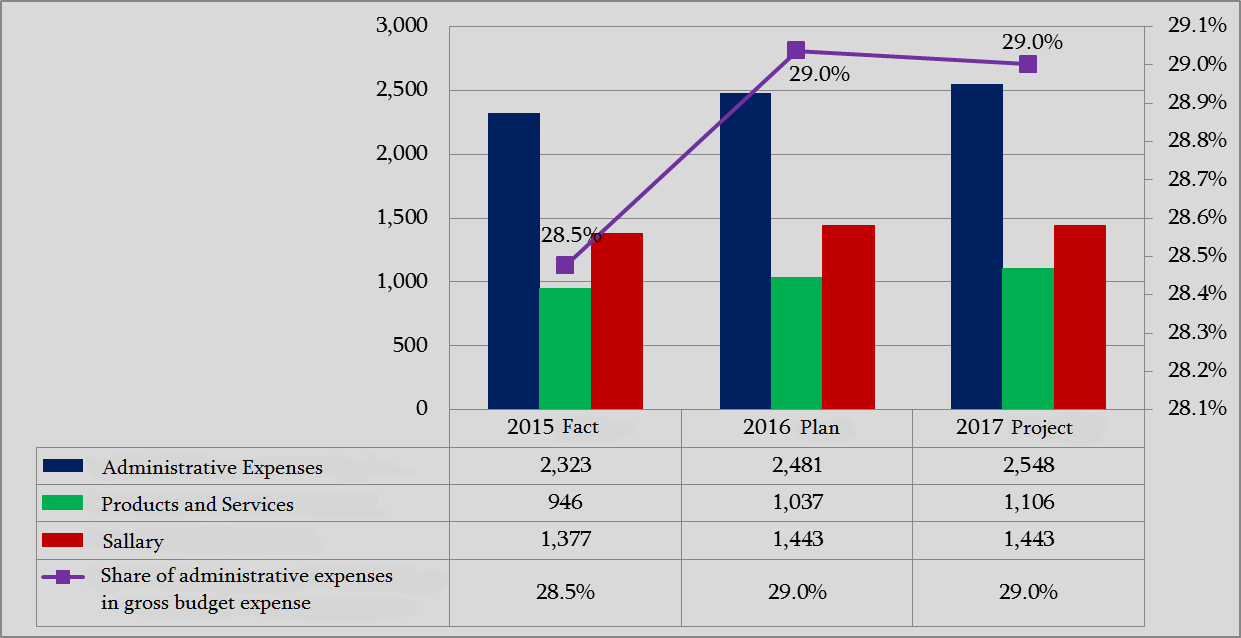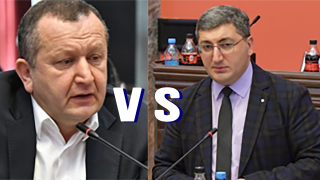Deputy Minister of Finance, Giorgi Kakauridze, whilst speaking about the 2017 draft budget, stated: “Administrative expenses, including labour remuneration, have either decreased or remain at the previous level in every ministry. In total, the labour remuneration fund is the same as it was in 2016.”
FactCheck took interest in the accuracy of the statement.
Administrative expenses in the state budget are categorised under the labour remuneration and goods and services budget lines. These budget lines, apart from purely bureaucratic expenses (financing the activities of the executive and representative organs), include labour remuneration for those employed in the public sector. They also include purchasing necessary goods and services to carry out the functions of public servants.
According to the draft budget of 2017, GEL 1,443 million is envisaged in the labour remuneration budget line which is equal to what it was in the 2016 budget. However, the expenses for purchasing goods and services is increased by GEL 69 million. In total, administrative expenses are planned to amount GEL 2,548 million.
Graph 1: Dynamics of Changes in the Budget’s Administrative Expenses (GEL million)
 Source: Ministry of Finance of Georgia
Of note is that in order to assess the changes in administrative expenses, it is better to use relative indicators calculated vis-à-vis the expenses part of the budget rather than using absolute data. As illustrated in the graph, the 2017 budget’s administrative expenses, similar to those of the 2016 budget, are planned to reach 29% of the total expenses.
Table 1: Trend of Changes in Labour Remuneration
Source: Ministry of Finance of Georgia
Of note is that in order to assess the changes in administrative expenses, it is better to use relative indicators calculated vis-à-vis the expenses part of the budget rather than using absolute data. As illustrated in the graph, the 2017 budget’s administrative expenses, similar to those of the 2016 budget, are planned to reach 29% of the total expenses.
Table 1: Trend of Changes in Labour Remuneration
Source: Ministry of Finance of Georgia
As illustrated from the table, according to the draft budget of 2017, the funds for labour remuneration in the ministries is either equal to or below the amount planned in the 2016 budget. The situation is the same for the ministry staff. The exceptions are the Ministry of Defence, Ministry of Foreign Affairs, Ministry of Environment and Natural Resources Protection and the Ministry of Culture and Monument Protection. In these cases, however, the level of growth is negligible.
Of interest is the situation in terms of the consolidated budget. The consolidated budget is the combined budget of the state, the autonomous republics and the self-governing bodies and is not subject to the approval or adoption of any structural unit. However, the consolidated budget is important in terms of information because it includes data about every state institution. In the consolidated draft budget for 2017, administrative expenses (labour remuneration + goods and services) will be increased by GEL 195 million as compared to 2016 whilst the ratio of the budget’s administrative expenses to the consolidated budget in the 2017 draft budget is 8.5% which is similar to the 2016 budget.
Conclusion
According to the 2017 draft budget, the total amount of administrative expenses will be increased by GEL 68 million as compared to the 2016 budget. However, the ratio of administrative expenses to the total budget expenses remains at 29% which is similar to 2016. GEL 1,443 million is allocated for labour remuneration in the 2017 draft budget which equals the planned amount of the 2016 budget. Labour remuneration has not increased if the ministries are taken separately although there are a few exceptions where the growth is negligible.
However, administrative expenses increased by GEL 195 million in the consolidated budget. This indicates that the growth of administrative expenses is owing to the increase in administrative expenditures in the budgets of local self-governing bodies.
Therefore, FactCheck concludes that Giorgi Kakauridze’s statement is MOSTLY TRUE.
 Source: Ministry of Finance of Georgia
Of note is that in order to assess the changes in administrative expenses, it is better to use relative indicators calculated vis-à-vis the expenses part of the budget rather than using absolute data. As illustrated in the graph, the 2017 budget’s administrative expenses, similar to those of the 2016 budget, are planned to reach 29% of the total expenses.
Table 1: Trend of Changes in Labour Remuneration
Source: Ministry of Finance of Georgia
Of note is that in order to assess the changes in administrative expenses, it is better to use relative indicators calculated vis-à-vis the expenses part of the budget rather than using absolute data. As illustrated in the graph, the 2017 budget’s administrative expenses, similar to those of the 2016 budget, are planned to reach 29% of the total expenses.
Table 1: Trend of Changes in Labour Remuneration
| Spender Institutions | 2015 Fact | 2016 Plan | 2017 Draft |
| Ministry of Finance | 112.7 | 90.00 | 85.00 |
| Ministry of Economy and Sustainable Development | 13.8 | 13.9 | 12.9 |
| Ministry of Regional Development and Infrastructure | 8.4 | 8.4 | 7.9 |
| Ministry of Justice | 38.3 | 38.1 | 36.7 |
| Ministry of Corrections and Legal Assistance | 67.5 | 66.6 | 66.4 |
| Ministry of Foreign Affairs | 7.8 | 7.7 | 7.8 |
| Ministry of Defence | 418.4 | 405 | 407.4 |
| Ministry of Internal Affairs | 373.9 | 394.0 | 394.0 |
| Ministry of Education and Science | 22.3 | 23.3 | 22.9 |
| Ministry of Culture and Monument Protection | 54.6 | 55.2 | 56.2 |
| Ministry of Internally Displaced Persons from the Occupied Territories, Accommodation and Refugees | 4.6 | 4.5 | 4.4 |
| Ministry of Labour, Health and Social Affairs | 33.6 | 31.5 | 31.5 |
| Ministry of Energy | 2.9 | 2.7 | 2.6 |
| Ministry of Agriculture | 20.5 | 20.8 | 20.5 |
| Ministry of Environment and Natural Resources Protection | 21.2 | 21.1 | 21.4 |
| Ministry of Sport and Youth Affairs | 5.1 | 4.6 | 4.5 |
Tags:








